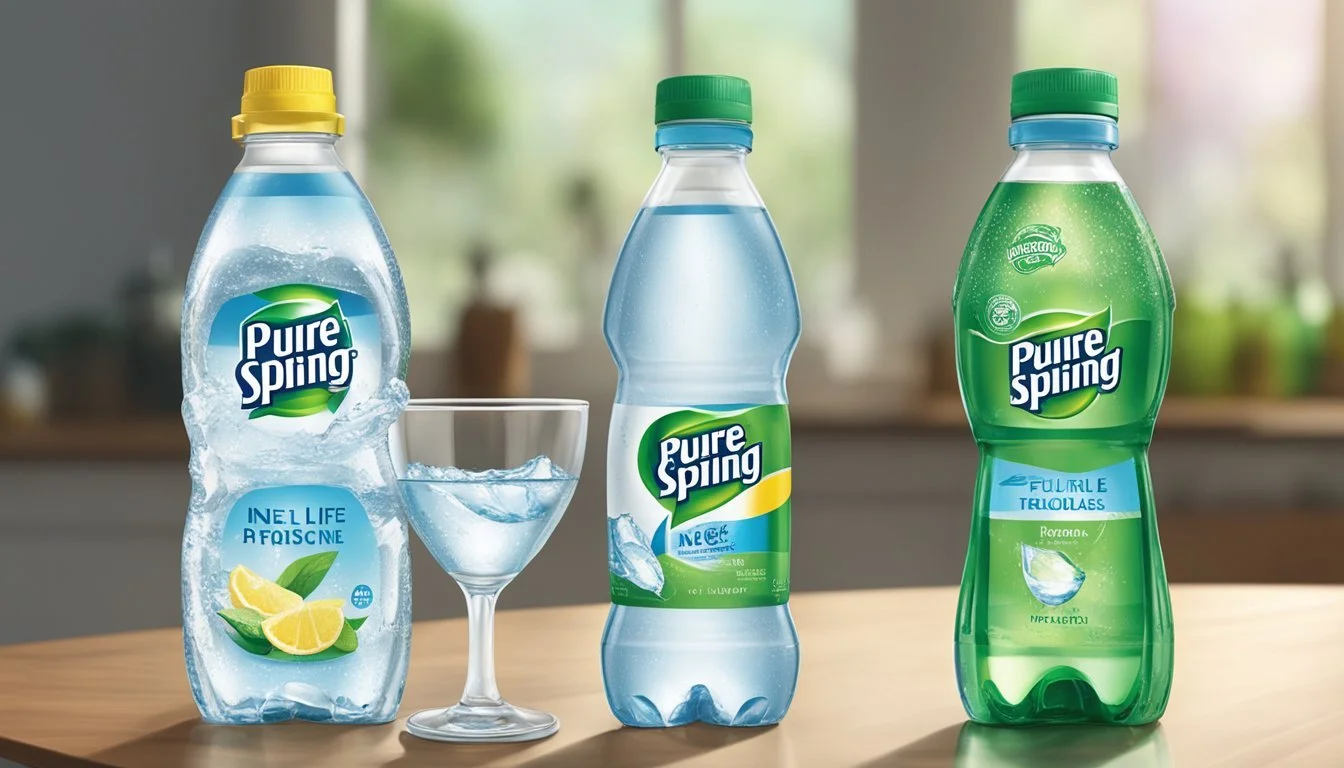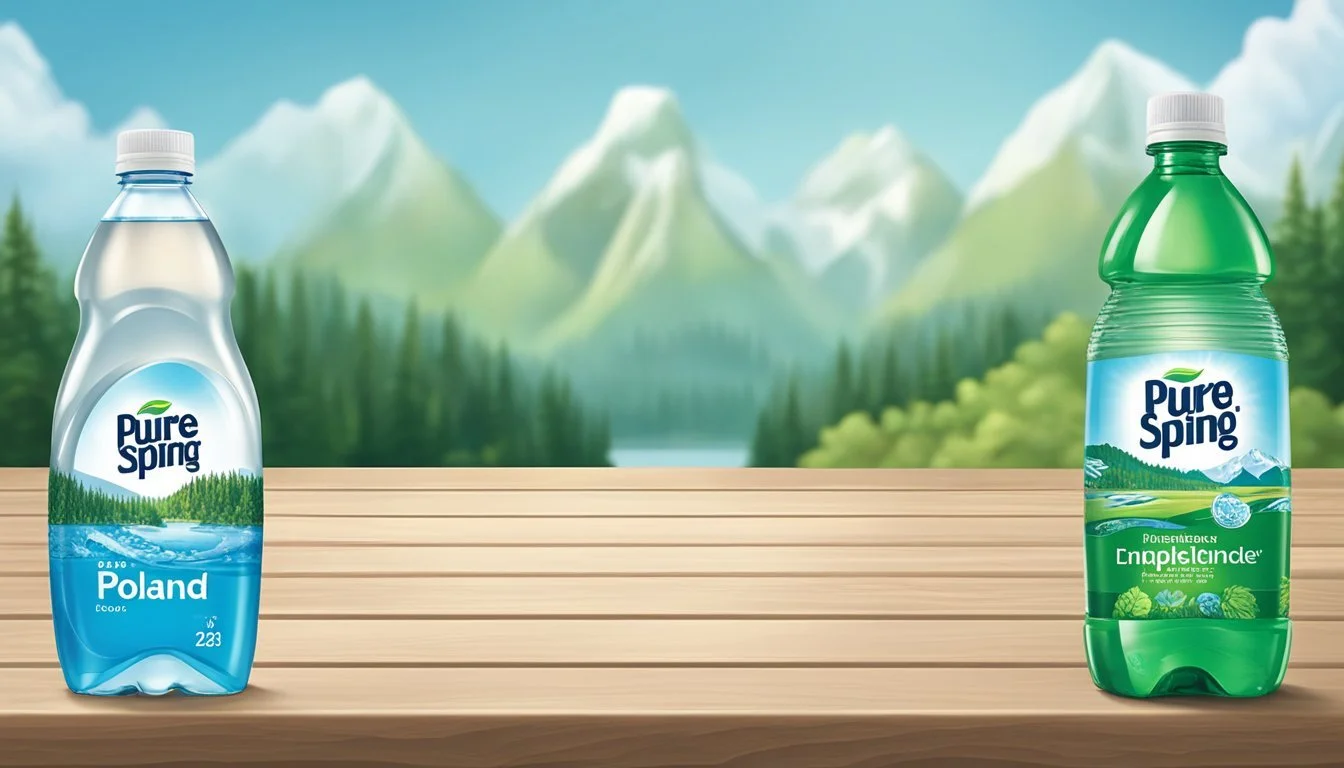Nestlé Pure Life vs. Poland Spring
Comparing Quality and Taste
Nestlé Pure Life and Poland Spring represent two prominent players in the bottled water market, each with its distinct sourcing and branding strategies. Nestlé Pure Life, a product of the world’s largest bottled water company, is known for its purified water, which undergoes a multi-step process of filtration. It aims to provide a consistent taste and quality across its products by adhering to specific purification standards.
Poland Spring, on the other hand, boasts a heritage of sourcing 100% natural spring water from Maine since 1845. The brand has built its reputation on this regional identity and its commitment to delivering water directly from natural springs. This commitment, however, has not been without controversy, as legal challenges have questioned the authenticity of the spring water claim.
Consumers looking to choose between Nestlé Pure Life and Poland Spring often consider factors such as taste, source, purity, and the environmental impact of the brands. Environmental consciousness and sustainability efforts by the companies are increasingly becoming part of the decision-making process for individuals who are mindful of the ecological footprint of bottled water. As the bottled water industry faces scrutiny over its environmental practices, Nestlé and Poland Spring strive to position themselves as both healthful and responsible choices.
Exploring the Brands
In this section, readers will discover the origins and historical significance of two renowned bottled water brands: Nestlé Pure Life and Poland Spring.
History of Nestlé Pure Life
Nestlé Pure Life began as a response to the growing demand for bottled water in the United States. Launched by the Nestlé company, which is known as the largest food and beverage company in the world, Nestlé Pure Life caters to the market with a promise of providing purified water. The brand quickly made an impact by offering consistently clean and safe bottled water obtained from well-protected sources, treated with a multi-step purification process.
History of Poland Spring
Poland Spring originates from the state of Maine, where its source has been renowned for centuries. The brand's heritage dates back to the 1800s, establishing itself as a local choice and gradually earning national recognition. Poland Spring prides itself on delivering natural spring water carefully sourced from specific springs in Maine, retaining the unique mineral composition that characterizes the taste and quality of its water.
Water Source and Natural Environment
The purity and quality of bottled water can often be traced back to its source. This section evaluates the water sources for Nestlé Pure Life and Poland Spring, emphasizing their natural environments.
Nestlé Pure Life's Sources
Nestlé Pure Life sources its water from multiple locations, often depending on public water supplies before undergoing a rigorous purification process. This water originates from well or municipal sources and is not typically associated with natural spring water. Despite this, Nestlé ensures that the water meets strict safety standards before it is bottled.
Poland Spring's Sources
Poland Spring claims its water is 100% natural spring water, sourced from springs in Maine. These springs are said to derive their water from underground aquifers that are naturally filtered through dense layers of glacial sands. However, controversy has arisen over whether some sources are truly from springs or just treated groundwater. Despite this, Poland Spring maintains that their water is collected from multiple springs, such as Evergreen Spring in Fryeburg or Clear Spring in Hollis.
Quality and Safety Standards
The evaluation of Nestlé Pure Life and Poland Spring involves closely examining their filtration processes and adherence to safety and contamination standards. These standards are critical to ensuring the water is safe for consumption and of high quality.
Filtration Process
Nestlé Pure Life employs a multi-step filtration process that includes reverse osmosis and ultraviolet light exposure. Reverse osmosis involves pushing water through a semi-permeable membrane to remove dissolved solids, while ultraviolet light helps to disinfect the water. Additionally, ozone is used for further disinfection before bottling, effectively eliminating a wide range of potential contaminants.
Poland Spring, on the other hand, sources its water from springs and emphasizes its natural filtration through mineral-rich aquifers. Poland Spring's process also consists of employing filtration methods and ozone to ensure the final product meets the required safety standards.
Safety and Contamination Standards
Both brands adhere to stringent safety standards mandated by the Environmental Protection Agency (EPA), which includes regular monitoring for contaminants like bacteria, heavy metals, and fluoride. Tests are done to ensure the absence of harmful levels of BPA in the bottles and to maintain minimal contamination by chlorine and other disinfection byproducts.
Nestlé Pure Life:
Chlorine: Used in small amounts for initial purification.
Heavy Metals & Fluoride: Regularly tested to meet EPA limits.
Bottle Safety: BPA-free bottles are used to prevent chemical leaching.
Poland Spring:
Chlorine: Not typically used due to the natural purity of spring water.
Contaminants: Monitored to comply with EPA regulations.
Disinfection: Utilizes ozone for maintaining the water's sterility without adding harmful chemicals.
Taste Profile and Composition
The taste and composition of bottled water are influenced by its mineral content and pH levels. Each brand has its unique profile that caters to consumer preferences.
Mineral Content and Taste
Nestlé Pure Life water undergoes a multi-step process of filtration and purification, with minerals added back for taste. The result is a consistent and neutral flavor profile. Its mineral composition typically includes calcium, magnesium, and sodium, carefully added to enhance taste:
Calcium: Contributes to a smoother taste.
Magnesium: Can add a slightly bitter note, but within a balanced profile.
Sodium: Used sparingly to avoid a salty taste.
Poland Spring, on the other hand, sources its water from natural springs. The mineral content is naturally occurring and can include a mix of minerals, offering a fresh and clean taste with a hint of natural sweetness due to the electrolytes. The presence of naturally dissolved minerals such as calcium, magnesium, and sodium is responsible for the characteristic taste that many consumers find refreshing.
PH Levels and Acidity
The pH level of bottled water affects its acidity or alkalinity, which can influence taste perception and compatibility with certain dietary preferences. Generally, a neutral pH is around 7, with lower values being more acidic and higher ones being more alkaline.
Nestlé Pure Life: Targets a neutral pH level after its purification and mineralization process, typically ranging around 6.5 to 7.5. This range is intended to produce water that is neither noticeably acidic nor alkaline to most palates.
Poland Spring: Since it is natural spring water, the pH levels can vary slightly depending on the specific source, but it generally maintains a mildly alkaline profile, often found to be between 6.5 and 7.5, similar to Nestlé Pure Life.
Both brands manage to keep their pH levels in a range that most consumers find palatable and refreshing. The subtle differences in pH levels between Nestlé Pure Life and Poland Spring are a part of their natural character and do not typically affect the consumers' preference significantly when it comes to taste.
Environmental Impact and Sustainability
When considering the environmental impact and sustainability of bottled water brands such as Nestlé Pure Life and Poland Spring, two primary areas are critical: bottle production and disposal, and water sourcing and resource management. Both factors carry significant weights in assessing the long-term viability and ecological footprint of these products.
Bottle Production and Disposal
Nestlé Pure Life and Poland Spring use various types of bottles, predominantly those made from plastic. Plastic bottles contribute substantially to environmental waste, with BlueTriton, the owner of Poland Spring, recognized for contributing millions of pounds of plastic waste annually. Both these brands, however, have taken measures to include recycled plastic in their bottles, thus reducing their environmental impact to some extent.
Nestlé Pure Life: Incorporates materials from various public water sources and groundwater that are then packaged in plastic bottles, with a certain percentage coming from recycled plastics.
Poland Spring: Offers products such as Poland Spring Origin in bottles made from 100% recycled plastic, addressing the environmental concern of bottle disposal.
Water Sourcing and Resource Management
The sustainability of a water brand also heavily relies on its sourcing and resource management practices. The extraction of water from natural resources can lead to depletion and affect local ecosystems.
Nestlé Pure Life: Draws water from groundwater and public water sources, where they emphasize water stewardship to maintain the balance of natural resources.
Poland Spring: Claims its water is 100% Natural Spring Water, indicating a single-source origin which, if managed responsibly, could lower the impact on the environment.
Both brands face the challenge of balancing consumer demand with the responsibility of minimizing the strain on water sources and the broader environment. The implementation of sustainable practices and promoting the use of glass bottles or recycled plastic are steps towards reducing their ecological footprint.
Consumer Experience
When choosing bottled water, consumers often weigh the convenience of packaging and the affordability within their budget. These aspects deeply influence the usability and popularity between Nestlé Pure Life and Poland Spring.
Packaging and Convenience
Nestlé Pure Life and Poland Spring bottles come in a variety of sizes, providing options for different needs. Poland Spring offers boldly labeled bottles with a distinctive green aesthetic, while Nestlé Pure Life features a blue label and a simple design that emphasizes its focus on purity. The packaging of both brands is designed to ensure easy handling and portability, aligning with consumers' desires for convenience.
Additionally, both brands are readily available in most retail outlets, including Amazon, allowing for easy access to their products. The ease of obtaining these bottled waters adds to the overall consumer experience, offering a sense of fresh and clean drinking options on the go.
Price Comparison
In terms of price, both Poland Spring and Nestlé Pure Life are competitively positioned. A direct price comparison may vary based on the retailer, location, and promotional offers. However, it's observed that, generally speaking, Nestlé Pure Life tends to be slightly more budget-friendly than Poland Spring.
Below is a simplified price comparison based on a standard 500ml (16.9oz) bottle purchased from Amazon:
Brand Price per Bottle Nestlé Pure Life $0.20 - $0.30 Poland Spring $0.25 - $0.35
Note that prices are subject to change and can be influenced by factors such as sales volume, point of purchase, and available discounts. Consumers are inclined to choose the brand that fits within their financial comfort while satisfying their need for crisp, purified water.
Comparative Analysis
When evaluating bottled water options, consumers often look at brand reputation and the direct comparison of product quality. The following analysis between Nestlé Pure Life and Poland Spring centers on these facets, providing insights into their market presence and a head-to-head comparison of the water brands.
Brand Reputation and Market Presence
Nestlé Pure Life is a product of Nestlé Waters, a subsidiary of Nestlé, which claims to be the world's largest food and beverage company. This brand has a significant global footprint and offers a range of products that cater to various consumer needs for hydration. Nestle's market strategy often emphasizes the brand's dedication to quality and consistent taste.
On the other hand, Poland Spring is a regional brand originating from Maine, United States, and is owned by BlueTriton Brands, previously part of Nestlé Waters. Known for its natural spring water, Poland Spring has built a reputation for offering water sourced from specific springs in the state of Maine. Their marketing often touts the natural purity of their water.
Aspect Nestlé Pure Life Poland Spring Market Presence Global Primarily Northeastern USA Ownership Nestlé BlueTriton Brands (formerly part of Nestlé Waters) Sourcing Public/municipal sources & protected wells Natural springs in Maine Primary Selling Point Quality and consistent taste Natural purity from specific spring sources
Direct Comparison: Nestlé Pure Life vs. Poland Spring
In a direct comparison of Nestlé Pure Life and Poland Spring, both bottled waters serve the purpose of providing hydration. However, they differ in their source and treatment processes. Nestlé Pure Life is purified water, which means it comes from public water sources or well water and is treated to remove dissolved solids and other impurities, whereas Poland Spring is categorized as spring water, sourced from naturally occurring springs, and boasts a unique mineral composition that varies depending on the regional source.
The quality of both brands is strictly regulated by the Food and Drug Administration (FDA), ensuring they meet national standards for bottled water. While Nestlé Pure Life may appeal to a broad range of consumers looking for a dependable and consistent taste, Poland Spring might attract those seeking a regional brand with a natural backdrop in its marketing narrative.
Feature Nestlé Pure Life Poland Spring Source Public/municipal sources & protected wells Natural springs Treatment Purified with added minerals Natural minerals and filtration Taste Profile Consistent and neutral Varies by source, potentially more mineral taste Quality Control FDA regulated FDA regulated Brand Image Global, accessible hydration Regional, natural purity
Alternatives to Bottled Water
While bottled waters like Nestlé Pure Life and Poland Spring are popular choices for many, alternatives such as tap water and filtration systems offer cost-effective and environmentally friendly options.
Tap Water and Public Sources
Tap water, typically sourced from local reservoirs, rivers, or underground sources, is a widely available alternative to bottled water. It is regulated by government organizations, like the EPA in the United States, to ensure safety and quality standards are met. Public drinking fountains, often found in parks and community spaces, provide spring water or purified water that has undergone similar treatment processes. In certain regions, such as Norway or Iceland, natural springs offer high-quality public water rich in minerals and with a unique taste profile.
Advantages:
Cost-effective; often free or minimal cost
Reduced environmental impact compared to plastic bottles
Accessibility in public spaces and homes
Considerations:
Local water quality can vary; occasionally susceptible to contamination
Taste and odor may differ from bottled water due to chlorine and other treatments
Filtered Water and Home Solutions
For those seeking an alternative to tap water's taste or further assurance of quality, filtered water systems provide a solution. Pitchers, faucet attachments, or under-sink units can remove contaminants and improve taste. High-end water filters can produce water that rivals bottled waters like Fiji, Voss, or Evian. Reverse osmosis and activated carbon filters are two common methods used in these home systems. Additionally, specialty waters such as alkaline water or artesian water, like Fiji Natural Artesian Water or Voss, can be simulated with home ionizers or mineral cartridges.
Advantages:
Customizable filtration for specific water quality needs
Potential cost savings over time compared to buying bottled water
Environmental benefits by reducing plastic waste
Considerations:
Initial investment for a home filtration system
Maintenance and filter replacement required for optimal performance
Conclusion
Choosing between Nestlé Pure Life and Poland Spring hinges on individual preferences and priorities. Nestlé Pure Life is classified as purified water, which is sourced from wells or municipal supplies and then treated. In contrast, Poland Spring brands itself as "100% natural spring water."
Taste can vary between these brands due to the different sources and treatment methods used. Environmental considerations also play a role; both brands have faced scrutiny over sustainability practices, with Nestlé Pure Life having a larger corporate footprint.
When it comes to accessibility, Nestlé's Pure Life is widely available due to the company's vast distribution network. Poland Spring, despite its regional origins, has broad availability across the United States.
In terms of product offerings, both brands provide a range of sizes and packaging options to cater to diverse needs, from personal bottles to larger multi-packs suitable for families and events.
Consumers may also consider brand reputation and ethical considerations. Lawsuits and public perception can influence the decision-making process for some buyers. Ultimately, the choice between Nestlé Pure Life and Poland Spring should be based on personal taste preferences, convenience, environmental concerns, and trust in the brand.










